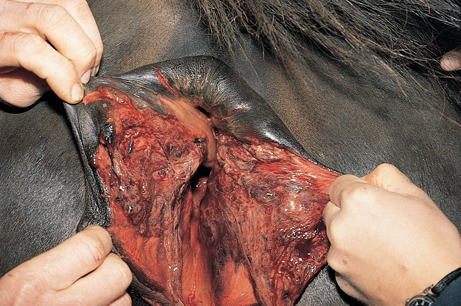Difference between revisions of "Equine Reproduction and Stud Medicine Q&A 18"
| Line 21: | Line 21: | ||
(4) eliminate injury to other pelvic organs if possible (uterine haemorrhage, middle uterine artery tear, prolapsed bladder, injury to the small or large colon by the foal’s hind legs). | (4) eliminate injury to other pelvic organs if possible (uterine haemorrhage, middle uterine artery tear, prolapsed bladder, injury to the small or large colon by the foal’s hind legs). | ||
| − | |l1= | + | |l1= |
|q2= When can you repair this type of injury? | |q2= When can you repair this type of injury? | ||
|a2= Where foaling and injury has occurred less than 3 hours before examination, immediate repair can be investigated but is rarely indicated. Usually severe bruising and laceration are present and repair should be delayed until granulation of the area occurs in 6–8 weeks or even longer. | |a2= Where foaling and injury has occurred less than 3 hours before examination, immediate repair can be investigated but is rarely indicated. Usually severe bruising and laceration are present and repair should be delayed until granulation of the area occurs in 6–8 weeks or even longer. | ||
| − | |l2= | + | |l2= |
|q3= What two common surgical techniques can be used in this repair and how do they differ? | |q3= What two common surgical techniques can be used in this repair and how do they differ? | ||
|a3= (1) The Aanes technique is a two-stage repair: stage 1 reconstructs the rectovestibular shelf but leaves the perineal body open; in stage 2, the perineal body is closed 3–4 weeks later. | |a3= (1) The Aanes technique is a two-stage repair: stage 1 reconstructs the rectovestibular shelf but leaves the perineal body open; in stage 2, the perineal body is closed 3–4 weeks later. | ||
(2) The Goetze technique is a single-stage operation: the principle is to evert the rectal mucosa into the rectum and vaginal mucosa into the vagina with a form of purse string suture. | (2) The Goetze technique is a single-stage operation: the principle is to evert the rectal mucosa into the rectum and vaginal mucosa into the vagina with a form of purse string suture. | ||
| − | |l3= | + | |l3= |
</FlashCard> | </FlashCard> | ||
Revision as of 16:00, 19 June 2011
| This question was provided by Manson Publishing as part of the OVAL Project. See more Equine Reproduction and Stud Medicine questions |
A 3-year-old Warmblood mare has foaled her first foal and due to a head and leg displacement, has been presented to you 30 minutes after parturition with a severe 3rd degree perineal laceration as shown above:
| Question | Answer | Article | |
| What information would your preliminary assessment provide? | (1) Assessment of heart rate and mucous membrane colour (increasing rate and blanching of the mucous membranes indicate possible internal haemorrhage);
(2)careful palpation of the anterior vagina and rectum (a possible tear into the abdominal cavity or peri-rectal space); (3) assess the depth, site location of the tear and extent of severe deep-tissue injury; (4) eliminate injury to other pelvic organs if possible (uterine haemorrhage, middle uterine artery tear, prolapsed bladder, injury to the small or large colon by the foal’s hind legs). |
[[|Link to Article]] | |
| When can you repair this type of injury? | Where foaling and injury has occurred less than 3 hours before examination, immediate repair can be investigated but is rarely indicated. Usually severe bruising and laceration are present and repair should be delayed until granulation of the area occurs in 6–8 weeks or even longer.
|
[[|Link to Article]] | |
| What two common surgical techniques can be used in this repair and how do they differ? | (1) The Aanes technique is a two-stage repair: stage 1 reconstructs the rectovestibular shelf but leaves the perineal body open; in stage 2, the perineal body is closed 3–4 weeks later.
(2) The Goetze technique is a single-stage operation: the principle is to evert the rectal mucosa into the rectum and vaginal mucosa into the vagina with a form of purse string suture. |
[[|Link to Article]] | |
